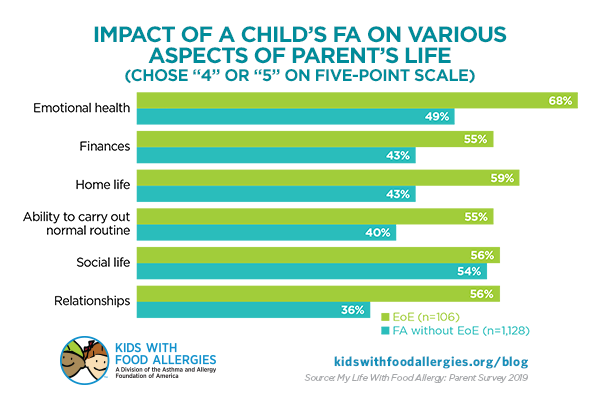White blood cells are the superheroes of our immune systems. They fight the “bad guys” – infections, bacteria, parasites, and diseases. But sometimes, these superheroes get confused about who they are supposed to fight. When that happens, your immune system might overreact to things that are supposed to be good, like food.
One type of white blood cell called an eosinophil [EE-oh-sin-oh-FILL] is an immune system superhero that can cause issues when too many of them collect in one area of your body. If they are there for a long time for no known reason, they can cause what’s called eosinophilic disease.
If too many of these cells collect in your esophagus (swallowing tube), it can cause eosinophilic [EE-oh-sin-oh-FILL-ick] esophagitis [uh-sof-uh-JIE-tis] – or simply EoE. Here are eight facts to know about EoE.
1. Food and pollen are the two most common triggers of EoE. In EoE, eosinophils collect in the esophagus and damage the lining. This is often the result of an immune response to food and/or pollen.
Common EoE symptoms include:
- Reflux that does not respond to usual medical therapy (this includes proton pump inhibitors, which stop acid production in the stomach)
- Difficulty swallowing (dysphagia)
- Food impactions (food gets stuck in the throat)
- Nausea and vomiting
- Failure to thrive (poor growth or weight loss)
- Stomach or chest pain
- Poor appetite
- Malnutrition
- Difficulty sleeping

2. EoE symptoms can be similar to symptoms of gastroesophageal reflux disease (GERD). GERD also causes eosinophils in the esophagus. It is important for other conditions with similar symptoms, such as GERD, to be ruled out before EoE can be accurately diagnosed.
3. EoE is diagnosed through a test called an upper endoscopy. If you or your child have symptoms of EoE, your doctor may recommend this type of test. It is also called an esophagogastroduodenoscopy (EGD) or “scope.” During this test, a doctor called a gastroenterologist will send a long tube with a camera down the upper gastrointestinal (GI) tract. They take pictures and tissue samples of the esophagus and other parts of the GI tract. This helps doctors see if there are elevated levels of eosinophils in the tissue.
4. EoE treatment may involve a partnership between an allergist, a gastroenterologist, registered dietician, and you. Because EoE involves different systems of the body, you may work with these professionals to manage the condition. EoE can cause poor growth or weight loss in children, so working with a nutrition expert can be helpful.
5. EoE may be treated with two types of treatment – dietary changes and medicines. Sometimes these are done at the same time. Dietary treatment usually involves some type of elimination diet. This means you will remove certain foods from the diet. The most common foods removed are milk, egg, wheat, soy, nuts, and seafood. Your doctors will help you decide what foods need to be removed from your or your child’s diet.
6. The strictest type of diet for EoE is the elemental diet. An elemental diet is a liquid, formula-based diet. This special formula contains only amino acids and does not include any food-based sources of protein. Some people require a feeding tube to help with this type of diet.
7. An inhaler commonly used for asthma may help treat EoE. This inhaler will have a type of medicine called an inhaled corticosteroid (ICS). If ICS are used for EoE, they are swallowed instead of being inhaled. And when using an ICS for EoE, a spacer or valved holding chamber is not needed or recommended, unlike asthma where a spacer or chamber is recommended.
8. If symptoms go away with treatment, the doctor may recommend a food trial. A food trial is where you add foods back to the diet one at a time. This will help determine which foods cause reactions.

Managing EoE can be overwhelming, especially in children. It’s important to get extra support. KFA has several resources to help ease the burden of managing EoE.
- KFA community – Join our online support community to talk with other families managing food allergies in an encouraging environment.
- Formula Options for Infants and Toddlers With Food Allergies – Learn more about different types of formula options available, and what to do if you can’t afford formula.
- Safe Eats® Allergy-Friendly Recipes – Search our collection of more than 1,500 recipes that can be made free of several of the most common allergens.
- Allergy-Friendly Foods – Search our collection of allergy-friendly foods from several different allergy-friendly food companies.
May 16-22, 2021, is National Eosinophil Awareness Week. Help raise awareness about EoE with our awareness ribbons. You can share them on social media or use them as your profile image.
EoE is a complicated type of food allergy to manage. In AAFA’s “My Life With Food Allergy” parent survey, parents of children with EoE overwhelmingly report a higher negative impact on their quality of life than parents managing food allergy without EoE.

Download the “My Life With Food Allergy Parent Survey Report: Spotlight on Eosinophilic Esophagitis”





Comments (0)